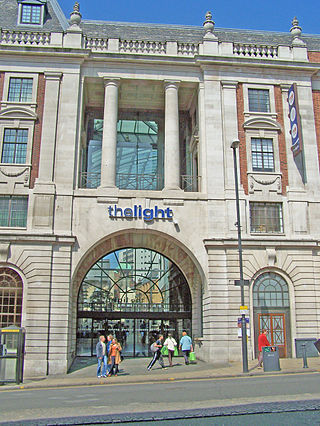
Staffordshire is a landlocked ceremonial county in the West Midlands of England. It borders Cheshire to the north-west, Derbyshire and Leicestershire to the east, Warwickshire to the south-east, the West Midlands county and Worcestershire to the south, and Shropshire to the west. The largest settlement is the city of Stoke-on-Trent, and the county town is Stafford.

Stafford is a market town and the county town of Staffordshire, England. It is located about 15 miles (24 km) south of Stoke-on-Trent, 15 miles (24 km) north of Wolverhampton, and 24 miles (39 km) northwest of Birmingham. The town had a population of 71,673 in 2021, and is the main settlement within the larger Borough of Stafford, which had a population of 136,837 in 2021.

Sir William Tite was an English architect who twice served as President of the Royal Institute of British Architects. He was particularly associated with various London buildings, with railway stations and cemetery projects. He was the Member of Parliament (MP) for Bath from 1855 until his death.

Eccleshall is a town and civil parish in the Stafford district, in the county of Staffordshire, England. It is located seven miles northwest of Stafford, and six miles west-southwest of Stone. Eccleshall is twinned with Sancerre in France.

Wellington is a market town of Telford and a civil parish in the borough of Telford and Wrekin, Shropshire, England. It is situated 3 miles (4.8 km) north-west of Telford town centre and 12 miles (19 km) east of Shrewsbury; the summit of The Wrekin lies 3 miles (4.8 km) south-west of the town. The population of the town was 25,554 in 2011.
The Stafford knot, more commonly known as the Staffordshire knot, is a distinctive three-looped knot that is the traditional symbol of the English county of Staffordshire and of its county town, Stafford. It is a particular representation of the simple overhand knot, the most basic knot of all.

Stoke-on-Trent railway station is a mainline railway station serving the city of Stoke-on-Trent, on the Stafford to Manchester branch of the West Coast Main Line. It also provides an interchange between local services running through Cheshire, Staffordshire and Derbyshire.

Barlaston is a village and civil parish in the borough of Stafford in the county of Staffordshire, England. It is roughly halfway between the city of Stoke-on-Trent and the small town of Stone. According to the 2001 census the population of the parish was 2,659, rising at the 2011 Census to 2,858.

Longport railway station serves the areas of Longport, Middleport, Tunstall and Burslem, all districts in the northern part of Stoke-on-Trent, England. The station is served by trains on the Crewe–Derby line, which is also a community rail line known as the North Staffordshire line. The station also has two trains a day on the Stoke-on-Trent to Manchester Piccadilly line. The station is owned by Network Rail and managed by East Midlands Railway.

Atherstone is a railway station serving the market town of Atherstone in Warwickshire, England. It is on the Trent Valley section of the West Coast Main Line, exactly 102 miles (164 km) from London Euston station.

Stone railway station serves the market town of Stone, Staffordshire, England. The station is located on a junction of the Colwich to Manchester spur of the West Coast Main Line, but has platforms only on the branch from Stafford to Stoke-on-Trent.

The Rugby–Birmingham–Stafford line is a railway line in the West Midlands of England. It is a loop off the West Coast Main Line (WCML) between Rugby and Stafford, via the West Midlands cities of Coventry, Birmingham and Wolverhampton. The direct route between Rugby and Stafford is the Trent Valley line.

The Leeds Permanent Building Society was a building society founded in Leeds, England in 1848 and was commonly known in a shortened form as The Leeds or The Perm. It should not be confused with the extant Leeds Building Society

Grindley railway station was a former British railway station to serve the village of Grindley in Staffordshire.

Stafford Common railway station was a former British railway station on the outskirts of Stafford.
Stafford Road F.C. was an English association football club founded in 1874, which now defunct. The club was connected to the Stafford Road railway works in Wolverhampton, then-Staffordshire.
The Stafford–Shrewsbury line is a former railway line in England, which ran between Stafford in Staffordshire and Shrewsbury in Shropshire, via Newport and Wellington, from 1849 to 1966. The Shropshire Union Railways and Canal Company (SUR&CC) constructed and ran one of the few railways in England ever built by a canal company. The line served Newport and Wellington stations. The SUR&CC were solely responsible for the section from Stafford to Wellington; but the building and operation of the 10.5 mile (17 km)-long Shrewsbury-to-Wellington section was shared with the Shrewsbury and Birmingham Railway.

Tonbridge Priory was a priory in Tonbridge, Kent, England that was established in 1124. It was destroyed by fire in 1337 and then rebuilt. The priory was disestablished in 1523. The building stood in 1735, but was a ruin by 1780. The remains of the priory were demolished in 1842 when the South Eastern Railway built the railway through Tonbridge, the original Tonbridge station standing on its site.

The North Stafford Hotel is a Grade II* listed hotel in Stoke-on-Trent, Staffordshire, England, opposite the city's railway station, also a Grade II* listed building.

Winton Square in Stoke-on-Trent, Staffordshire, England, houses Stoke-on-Trent railway station, the North Stafford Hotel, and several other historic structures. The square was built in 1848 for the North Staffordshire Railway, whose headquarters were in the station building, and is a significant example of neo-Jacobean architecture. Today, all the buildings and structures in the square are listed buildings and the square is a designated conservation area.
















